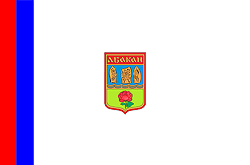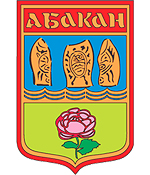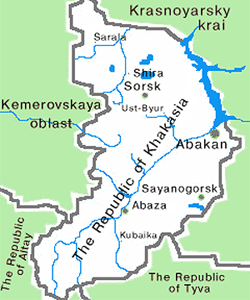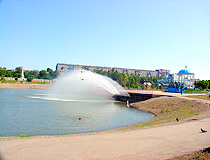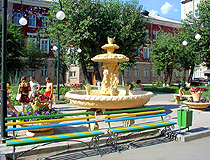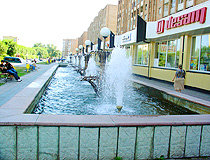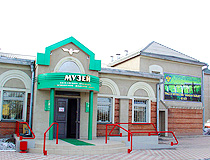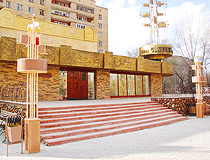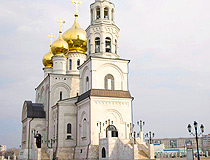Abakan - Overview
Abakan is a city in Russia, the capital of the Republic of Khakassia, located at the mouth of the Abakan River, which flows into the Yenisei, about 3,390 km east of Moscow and 400 km south of Krasnoyarsk.
According to the Federal State Statistics Service of Russia, the population of Abakan is about 184,300 (2025), the area - 112 sq. km.
The phone code - +7 3902, the postal codes - 655000-655018.
History of Abakan
Settlements near the mouth of the Abakan River existed at least from the Bronze Age. Locals called this hill “Ah-Tigey” (meaning “white top”, because there were numerous white birch bark yurts of nomads on this site). At the foot of Mount Samokhval, there was a Hun stone fortress. In the 1st century BC, about 8 km up the river, the so-called Li Ling Palace was built for the captive Chinese commander.
In 1675, on the Sosnovy Island at the mouth of the Abakan River, the first Russian fortress in Khakassia was founded - the fort of Abakansky. It was the first large military-engineering construction in the territory of the future city recorded in historical documents.
In 1706-1707, Peter the Great issued decrees on the construction of a new fort on the Abakan River. In 1707, it was built on the Yenisei River, about 21 km from the mouth of the Abakan River. 1707 is the year that Khakassia became part of Russia.
In the 1780s, the village of Ust-Abakanskoye was founded (the name literally means “standing at the mouth of the Abakan River”). In the 19th century, it became the center of the Abakan Steppe Duma, a self-governing body of the Khakass people. In 1859, the population of the village was 183. The new part of the village began to develop with the construction of the Achinsk-Minusinsk railway in 1914. But the First World War froze this project.
More historical facts…
In 1925, the Achinsk-Minusinsk railway was completed and the station of Abakan was opened. Construction of residential areas began between the village of the railway station and the village of Ust-Abakanskoye. By the end of the 1920s, 10,665 people lived here.
On October 20, 1930, a decision was made to establish the Khakass Autonomous Region. On April 30, 1931, the village of Ust-Abakanskoye was renamed the town of Abakan - the center of the Khakass Autonomous Region. In 1932-1933, a meat factory, a furniture factory, a train depot, and a power station were built in Abakan.
During the Second World War, the town continued to develop. There were several hospitals and evacuated enterprises here. In 1946, a confectionery factory, a juice factory began to operate, in 1950 - a textile factory. In 1950-1951, 400 individual residential buildings were built, in 1951 - the building of the movie theater “Pobeda” (“Victory”). In 1950, the population of Abakan was 37,7 thousand people.
During the construction of the Abakan-Tayshet railway, large construction organizations were opened in the town. In the 1960s, a bread factory was built in Abakan (1963), a knitwear factory (1967), a shoe factory (1969). The first capacities of the Abakan cargo river port (1967) were put into operation. In the early summer of 1969, the largest flood in the history of Abakan occurred. About 90% of the urban area was flooded.
In 1982-1985, Abakan was on the leading places in Russia in terms of development rates. In these years, the city was developing rapidly because of the construction of “Abakanvagonmash” (a railway car building plant). Present residential areas of the city were formed.
On May 16, 1992, Abakan became the capital of the Republic of Khakassia. The population of the city was about 156,000 people.
Abakan views
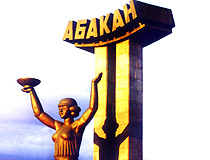
Lora stele - the symbol of Abakan
Author: Denis Lebedev
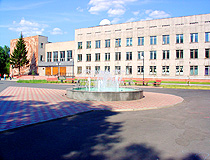
Fountain in Abakan
Author: Edward Yudanov
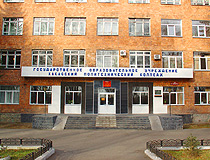
Khakass Polytechnic College in Abakan
Author: Edward Yudanov
Abakan - Features
Abakan is located in the central part of the Minusinsk depression, at an altitude of 250 m above sea level. The City Day of Abakan is celebrated in the penultimate Saturday of August.
It is connected with Moscow, Krasnoyarsk, Novokuznetsk, Barnaul by rail (Krasnoyarsk Railway). The federal highway R257 “Yenisei” from Krasnoyarsk to Tuva passes through Abakan and goes to the state border with Mongolia. The airport of Abakan offers regular flights to Moscow, Krasnoyarsk, Novosibirsk, Nokilsk.
The climate is sharply continental. Winter is long and moderately severe. Summer is warm with rare periods of hot weather. Spring comes in the second decade of April, and winter comes in the last decade of October. The air temperature is also softened thanks to the waters of the rivers of Abakan, Tasheba, and Yenisei.
In some years, snow is possible in June and August, in the mountains - in July, frosts can be in almost any month. The average temperature in January is minus 18 degrees Celsius, in July - plus 20 degrees Celsius.
On December 21, 2015, the largest solar power station in Siberia was opened in Abakan. The station has more than 20 thousand solar modules, and its area is 18 hectares.
Coat of arms of Abakan
The blue field symbolizes the sky and the Yenisei River. Images of golden statues remind of the collection of stone sculptures found in Abakan. The green field means the steppe surrounding the city. Trollius flower is a typical element of the local flora and symbolizes the prosperity of Abakan.
Abakan - Attractions
Abakan is the cultural center of Khakassia. The following cultural institutions are the most interesting ones:
- Khakass National Museum of Local Lore of L. R. Kyzlasov (Pushkina Street, 28a),
- Khakass Republican Philharmonic of V. G. Chaptykov (Lenina Avenue, 76),
- Center of Culture and Folk Art of S.P. Kadyshev (Lenina Avenue, 76),
- Abakan Art Gallery of F. Ye. Pronskikh (Shchetinkina Street, 65),
- Russian Republican Drama Theater of M. Yu. Lermontov (Shchetinkina Street, 12),
- Khakass National Drama Theater of A. M. Topanov (Shchetinkina Street, 12),
- Khakass National Puppet Theater “Fairy Tale” (Karla Marksa Street, 5),
- Khakass State Theater of Small Forms “Chitigen” (Khakasskaya Street, 56),
- Museum of the History of the Krasnoyarsk Railway at the Abakan Railway Station (Vokzalnaya Street, 21).
The layout of Abakan is mostly rectangular. In the south there are large blocks of one-story wooden buildings, the northern part is built up with multi-storey buildings. The central part has buildings of the 1930s-1950s. Green spaces occupy up to 1/3 of the city.
Some of the attractions of Abakan:
- “Lora” stele - the symbol of Abakan standing at the entrance to the city at the intersection of Druzhby Narodov and Severnaya Damba streets,
- monument to the liquidators of the Chernobyl accident (Tarasa Shevchenko Street, 83?),
- monument to A.S. Pushkin and sculptural compositions of the characters of Pushkin’s tales in a public garden between Khakasskaya and Pushkina streets,
- memorial of War Glory with Eternal Flame in Victory Park,
- architectural and park complex “Kind Angel of Peace” (Torgovaya Street, 28),
- city parks “Preobrazhenskiy”, “Chernogorskiy”, “Komsomolsky”, and “Orlyonok” (with rides for children),
- topiary parks (shrubs and trees are clipped into ornamental shapes) “Sady Mechty” (“Dream Gardens”) (K. Perekreshchenko Street, 11) and “Vdokhnoveniye” (“Inspiration”) (Sovetskaya Street, 51),
- monument to the two-time Olympic champion Ivan Yarygin with a fountain in the shape of Olympic rings (Krylova Street, 63),
- sculpture of the Little Prince (the intersection of Druzhby Narodov and K. Perekreshchenko streets, near “Preobrazhenskiy” Park),
- sculpture of the Dragonfly and the Ant (the intersection of Shchetinkina and Chertygasheva streets),
- monument to Lenin (Pervomayskaya Square),
- Transfiguration Cathedral (Sobornaya Square, 2).


